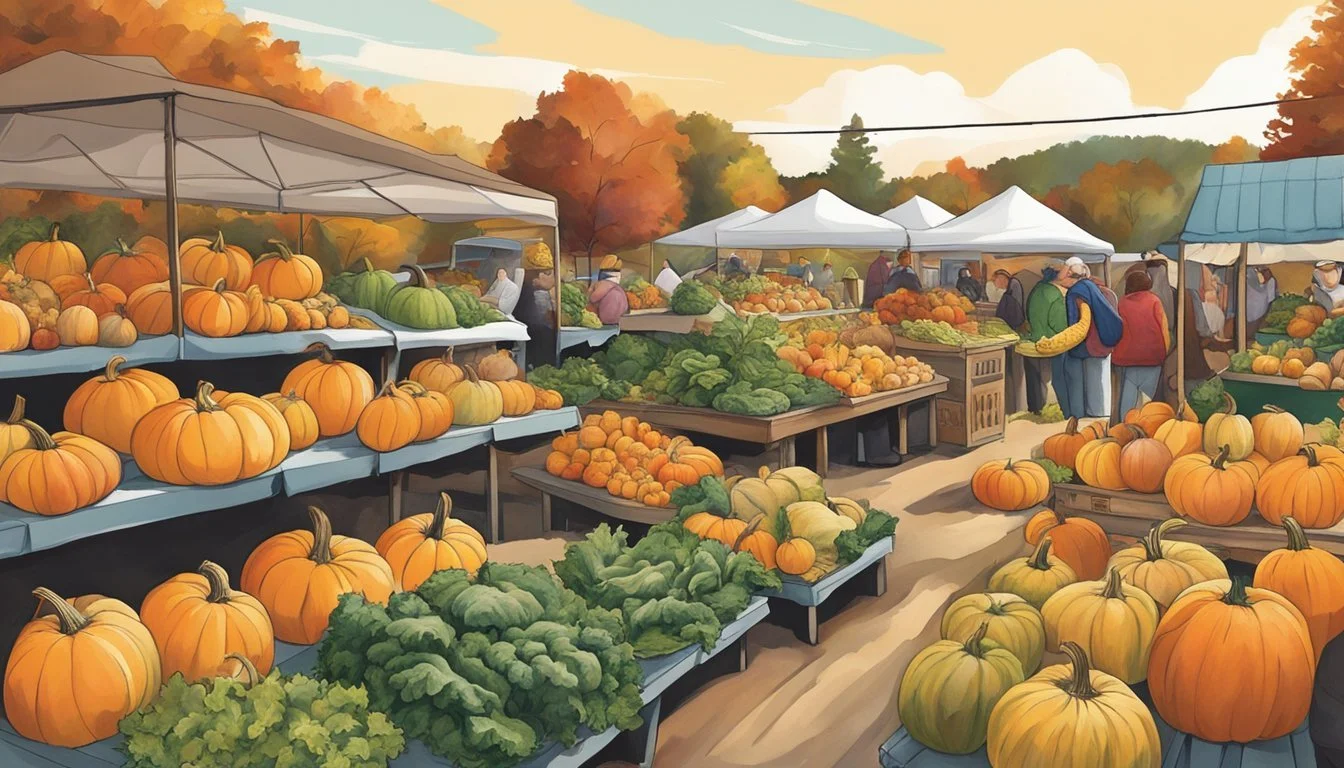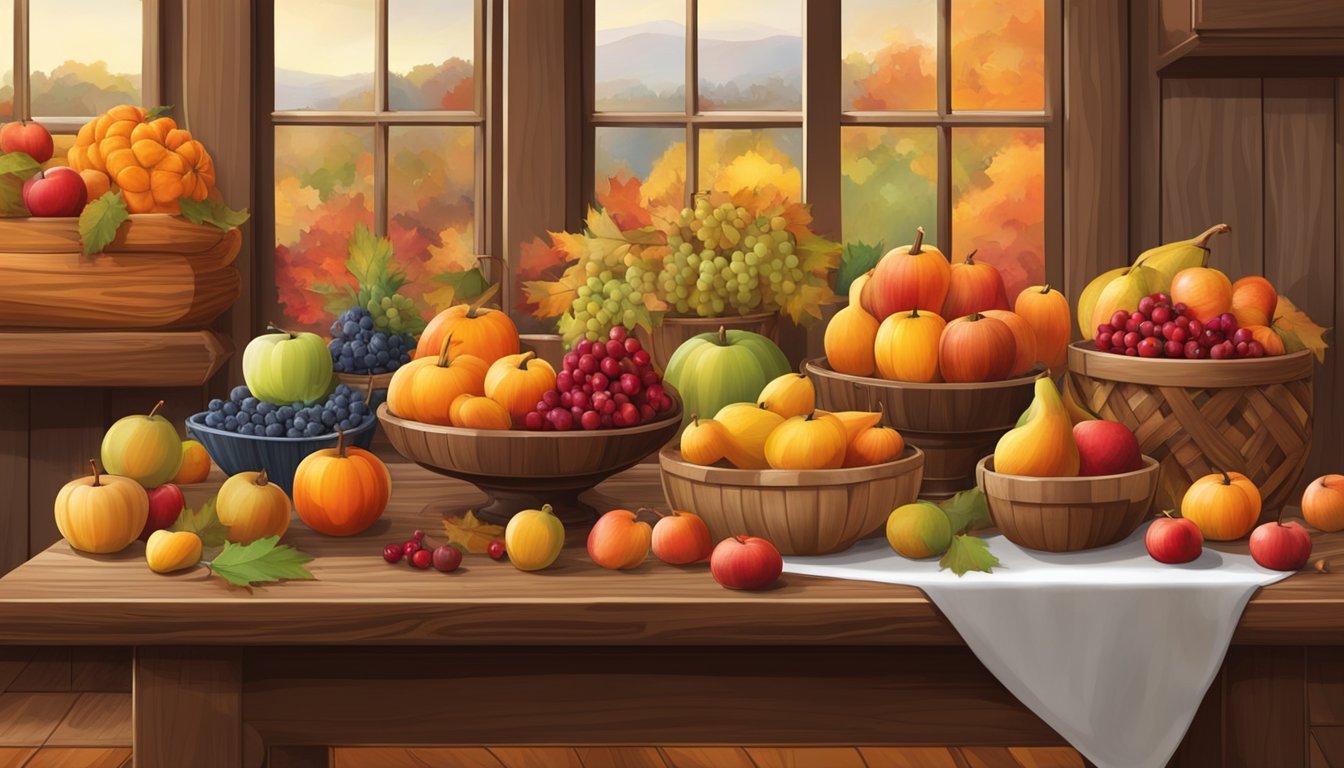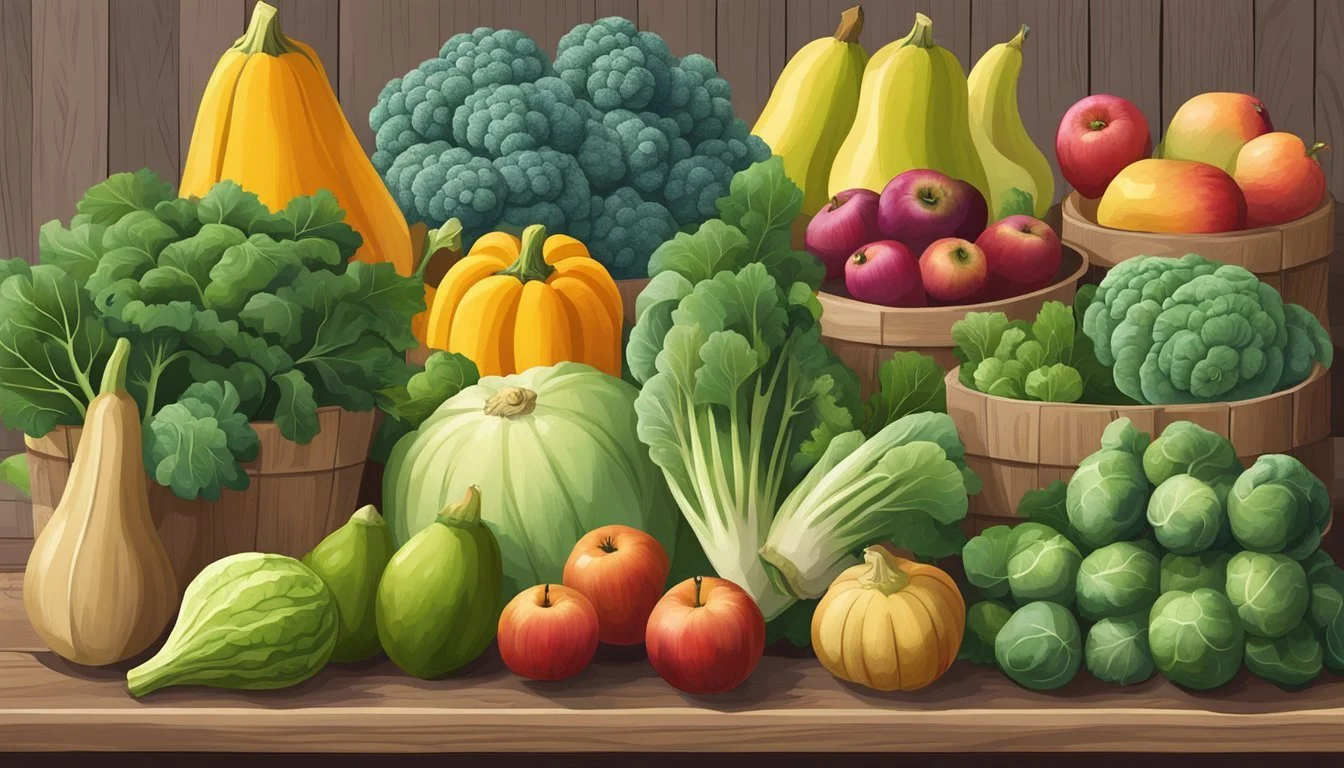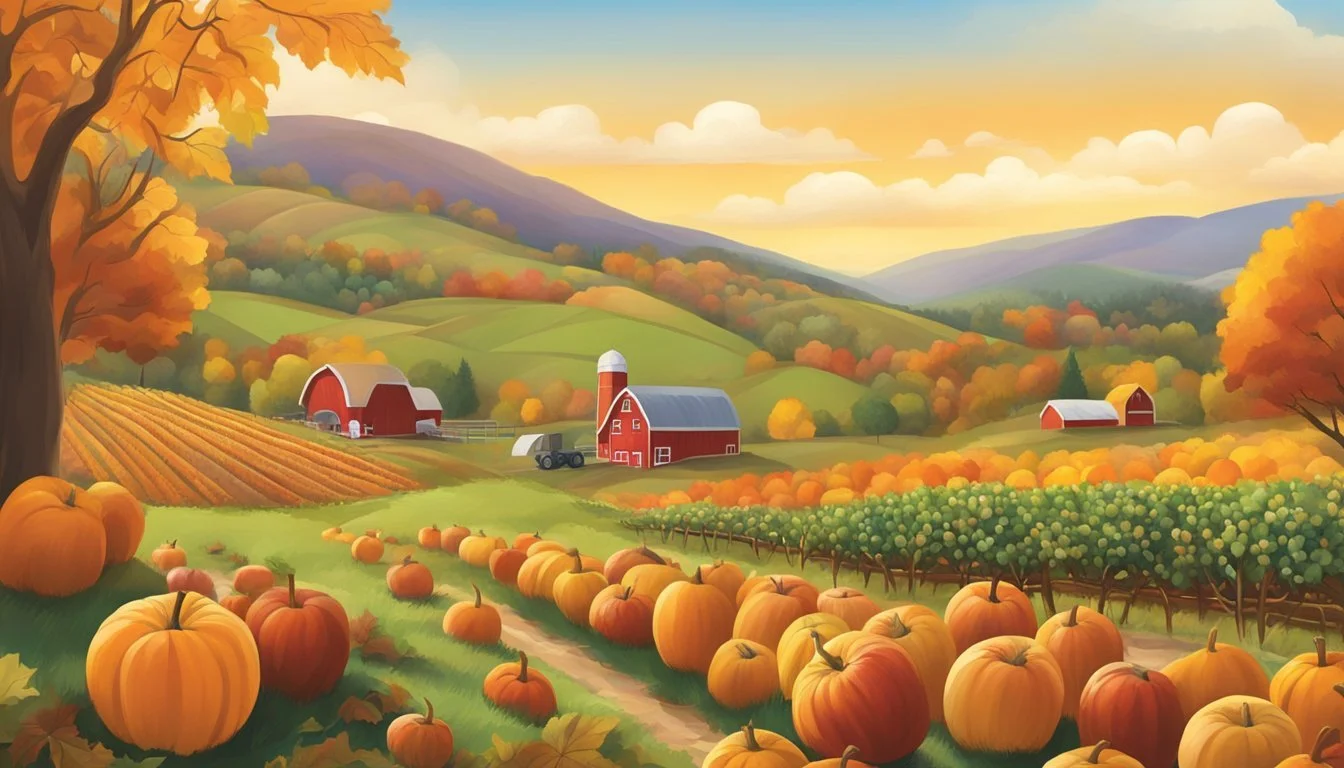Vermont Seasonal Fruit & Vegetables in November
A Guide to Fresh Produce Picks
This Article is Part of our Vermont Seasonal Fruit & Veg Calendar
November in Vermont is a time when the landscape transforms into a palette of deep oranges and browns, this change carries over into the produce that is in season. As temperatures drop, the focus shifts from the summer's abundance to heartier and more robust fare. The local harvest includes a myriad of root vegetables and cold-tolerant greens which become staples at farmers' markets and on the tables of Vermont residents.
In season this month, root vegetables like turnips, parsnips, and rutabagas provide a grounding complement to the dwindling days of autumn. These storage-friendly vegetables not only offer a rich source of nutrients but also carry the earthy flavors of the local terroir. Vermont's agriculture is well adapted to the shortening days, offering produce that is as resilient as it is nutritious.
Amidst the hardy vegetables, November also features the tail end of the apple harvest, a cornerstone of Vermont's agricultural output. Orchards work to distribute the last of their crop, ensuring that the crisp flavors of local apples (how long do apples last?) are available fresh, and also processed into cider, sauces, and pies. The presence of winter squash varieties like butternut, acorn, and spaghetti squash reflects the transition into the holiday season, bringing with them versatility and depth to the regional cuisine.
Understanding Vermont's Growing Season
In Vermont, the interplay of climate patterns and geography greatly influences the availability and flavor of locally grown produce. This directly affects when various fruits and vegetables reach their peak seasons for harvest.
Climate and Seasonal Shifts
Vermont experiences a full four-season climate characterized by cold and snowy winters and warm summers. Fall transitions quickly into winter around November, impacting the types of crops that can be harvested this late in the year. Gardeners and farmers must be cognizant of the first frost dates, which typically occur in October, to plan their harvests accordingly.
Regional Variations Within Vermont
The state's topography divides it into distinct regions, which can experience different microclimates. Map data indicates that areas such as the Northeast Kingdom have shorter growing seasons compared to the Lake Champlain Valley. Thus, availability of certain fruits and vegetables can vary within the state.
Importance of Seasonal Eating
Eating seasonally ensures that consumers enjoy the freshest flavors while also supporting the local economy. Produce that is in season is typically more abundant, tastier, and less expensive, often found readily at grocery stores and farm stands.
November in Vermont
During November, Vermont's growing season has wound down as winter begins to take hold. Late-season vegetables like carrots (how long do carrots last?) and kale (What wine goes well with kale?) can still be found, while the harvest of most fruits has ended. Gardens are being prepared for the coming spring.
Entity Overview
Winter: Impacts the end of the growing season and preparation for the next.
Fall: The last harvests of the year occur in this season.
Summer and Spring: Peak seasons for the widest variety of fresh produce.
Region: Geographic factors across Vermont affect harvest times and crop types.
United States: Vermont is part of the broader northeastern US climate and agricultural system.
Map: Useful tool for understanding regional climate differences.
Garden: In November, gardens are mostly dormant, awaiting spring.
Flavor: Seasonal produce harvested in November offers robust flavors.
Availability: More limited in November but includes hearty vegetables.
Grocery Stores: Still offer Vermont-grown produce, though variety decreases.
November: Marks a transition to winter and preparation for next year's growing season.
Fruits: Mostly out of season, with late varieties just finishing harvest.
Vegetables: Root vegetables and some hardy greens are still available.
Seasonal Fruits Available in November
In Vermont during November, the focus shifts to heartier tree fruits that thrive in the colder weather, as well as a smaller selection of berries and other fruits that can still be found at this time of year.
Tree Fruits
Apples: A prominent fruit of the season, Vermont orchards offer a variety of apples ranging from the sweet and crisp 'Honeycrisp' to the tart 'Granny Smith'. They are harvested in the fall and remain abundant throughout November.
Sweet Varieties: 'Fuji', 'Gala', 'Braeburn'
Tart Varieties: 'Empire', 'McIntosh', 'Cortland'
Pears: Less numerous than apples but equally delightful, pears such as 'Bosc' and 'Anjou' are in season. With their buttery texture and mellow sweetness, they are perfect for both fresh eating and baking.
Common Varieties: 'Bartlett', 'Bosc', 'Anjou'
Berries and Miscellaneous Fruits
Cranberries: While not traditionally grown in abundance like in other states, some specialty farms in Vermont may offer late-harvest cranberries. These tart berries are commonly used in sauces and baked goods.
Characteristics: Tart, Vibrant Red, Firm Texture
Persimmons: Although not a traditional Vermont fruit, persimmons may still be found in select markets during November. Enjoyed for their unique flavor, they should be eaten when fully ripe.
Types: 'Fuyu' (Sweet when firm), 'Hachiya' (Sweet when soft)
Pomegranates: Another less common fruit in Vermont, pomegranates can make an appearance in markets during early November. Known for their jewel-like seeds and tangy taste, they add a burst of flavor to a variety of dishes.
Known for: Antioxidant-rich Seeds, Sweet and Tart Taste
Seasonal Vegetables Available in November
November in Vermont cues the harvest of hardy vegetables that can thrive in the cooler temperatures. Shoppers will find an array of root vegetables and winter squashes along with various leafy greens and cruciferous vegetables that are not only fresh but also packed with nutrients.
Root Vegetables
Root vegetables reach their peak in November, offering both variety and rich flavors. Essential items include:
Beets: Different varieties like red, golden, and chioggia are available, known for their earthy taste and nutritional value.
Carrots: Carrots are sweet and crunchy, with varieties ranging from the classic orange to purple, yellow, and red.
Parsnips: These resemble white carrots and provide a sweet, nutty flavor, ideal for roasting.
Potatoes: A staple in many households, potatoes come in types such as Russet, Yukon gold, and red-skinned.
Sweet Potatoes: Not to be confused with yams, these are sweeter than regular potatoes and rich in beta-carotene.
Turnips and Rutabagas: Often used interchangeably, turnips are slightly milder than the more robust rutabagas.
Leafy Greens and Cruciferous Vegetables
Leafy greens and cruciferous vegetables available in November include:
Brussels Sprouts: These mini cabbages have a slightly bitter and nutty taste, perfect for roasting or sautéing.
Kale and Chard: Hearty greens that withstand the cold, kale, and chard offer versatility in cooking, from salads to sautéed sides.
Spinach and Lettuce: Tender spinach and various lettuce types are still harvestable, adding freshness to late autumn meals.
Winter Squash and Gourds
A beloved feature of fall, winter squash and gourds come in several forms:
Squash: Varieties such as butternut, acorn, and delicate are in abundance and can be roasted, mashed, or used in soups.
Pumpkins: Beyond decoration, pie pumpkins are ideal for cooking and rich in flavor.
Winter Squash: This category includes larger varieties like Hubbard and kabocha, which offer dense, sweet flesh perfect for hearty dishes.
Preparation and Recipe Suggestions
As November brings a plethora of seasonal produce to Vermont, she incorporates these fresh ingredients into her meals in a variety of ways. Her focus is on maximizing the natural flavors and nutritional benefits, often using herbs like sage and thyme to enhance the taste.
Comforting Soups and Stews
November's chill calls for hearty, warming dishes. Soup and stew recipes are excellent for pairing the earthiness of root vegetables like carrots, sweet potatoes, and beets with the robust flavors of herbs such as thyme and sage. Butternut squash soup, enriched with a hint of sage, provides a creamy and comforting meal, while a beef stew (What wine goes well with beef stew?) with chunks of carrots and potatoes gives sustenance and warmth.
Butternut Squash Soup: Purée roasted squash with vegetable stock, add sage, simmer, and serve.
Beef Stew: Brown beef, add diced carrots and potatoes, cover with broth, add thyme, and slow cook.
Roasting and Baking
The natural sugars in vegetables like beets, carrots, and sweet potatoes caramelize and intensify when roasted, offering a sweeter flavor and a satisfying texture. She often roasts these vegetables to serve as a side or incorporates them into savory pies and tarts. Roasted apples, sprinkled with cinnamon, can serve as a dessert on their own or be used as a filling for baked goods.
Roasted Root Vegetables: Toss beets, carrots, and sweet potatoes in olive oil, roast until tender.
Apple Tart: Layer thinly sliced apples over pastry crust, sprinkle with cinnamon, bake until golden.
Fresh Salads and Sides
Salads offer a refreshing balance to the richer flavors of autumn. She combines crisp greens like kale with seasonal fruits such as apples and cranberries for a fresh contrast. A sprinkle of fresh herbs or roasted nuts adds texture and depth. Hearty vegetables like squash and pumpkins can be added into salads as well, providing a satisfying element.
Kale and Apple Salad: Toss chopped kale with sliced apples, dried cranberries (how long do dried cranberries last?), roasted pumpkin seeds (how long do pumpkin seeds last?), and a vinaigrette.
Roasted Squash Salad: Mix roasted squash with greens, add a sprinkle of thyme, and dress lightly.
Where to Buy Seasonal Produce
In Vermont, November is a time of transition in nature's larder, yet it still offers an array of seasonal fruits and vegetables. Consumers looking to buy fresh, local produce have several options to consider, each catering to different preferences.
Local Farmers' Markets
Farmers' markets in Vermont are bustling hubs where shoppers can find fresh produce straight from the farm. Even in November, these markets often feature late-harvest vegetables such as root crops, winter squashes, and greenhouse-grown greens. A particular market's offerings can vary by region, but they typically provide a range of produce that reflects the local agricultural landscape.
Burlington Farmers' Market: Open year-round with seasonal variations in availability.
Montpelier Farmers' Market: Offers a selection of local goods through the winter months.
Grocery Stores and Co-ops
Grocery stores and food co-ops across Vermont stock a wide variety of produce, often emphasizing local and organic options. During November, they work with farmers to ensure that even out-of-season items are available, either through local greenhouses or regional sourcing.
City Market, Onion River Co-op: Located in Burlington, known for supporting local farmers.
Brattleboro Food Co-op: Provides a selection of local produce suited to the November harvest.
Community Supported Agriculture (CSA)
For those who value a direct connection with their food sources, Community Supported Agriculture (CSA) is an ideal choice. Participants receive shares of the harvest throughout the growing season, which in Vermont, can include the storage crops available in November. CSAs often provide distribution maps for pickup locations or offer delivery services within certain areas of the state.
Intervale Community Farm CSA: Known for an extensive range of produce, respecting the seasonality of Vermont's climate.
Pete's Greens CSA: Offers a diverse selection of vegetables, with a focus on sustainability and regional varieties.
Benefits of Eating Seasonally
When one chooses to eat seasonal fruits and vegetables, they are often met with produce that is fresh, flavorful, and abundant. Seasonal eating tends to offer a palette of benefits, particularly in the area of nutrition.
Nutritional Advantage
Seasonal produce typically presents a higher nutritional value because fruits and vegetables contain the most nutrients when they are freshly harvested. In November, Vermont's seasonal offerings can be quite robust.
Winter Squash: A variety of winter squashes are available, replete with vitamins A and C, alongside fiber and potassium. The textures range from firm and hearty, ideal for baking and soups, to creamy and sweet, perfect for pies and purees.
Greens: Winter greens such as kale and spinach thrive in colder temperatures, with a crisp texture and a slightly sweet flavor profile post-frost. They are packed with iron, calcium, and vitamins and provide a nutritious boost to any meal.
Freshness is not just about nutrients; it's also about taste. Eating seasonally means enjoying fruits and vegetables like winter squash when their flavor is at its peak—naturally sweet and full-bodied. Availability is another hallmark of seasonal eating. During their peak season, fruits and vegetables are more abundant and often less expensive, making them more accessible to the average consumer.







